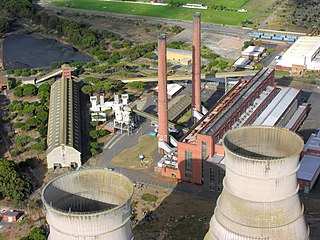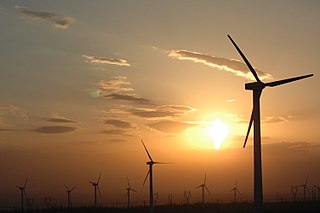
Electricity generation is the process of generating electric power from sources of primary energy. For utilities in the electric power industry, it is the stage prior to its delivery to end users or its storage.

A power station, also referred to as a power plant and sometimes generating station or generating plant, is an industrial facility for the generation of electric power. Power stations are generally connected to an electrical grid.

Microgeneration is the small-scale generation of heat and electric power by individuals, small businesses and communities to meet their own needs, as alternatives or supplements to traditional centralized grid-connected power. Although this may be motivated by practical considerations, such as unreliable grid power or long distance from the electrical grid, the term is mainly used currently for environmentally-conscious approaches that aspire to zero or low-carbon footprints or cost reduction. It differs from micropower in that it is principally concerned with fixed power plants rather than for use with mobile devices.

The Tanzania Electric Supply Company Limited (TANESCO) is a Tanzanian parastatal organisation established in 1964. It is wholly owned by the government of Tanzania. The Ministry of Energy and Minerals regulates the operations of TANESCO.

Wind power is one of the main renewable energy sources in Australia and contributed 10% of electricity supplied in 2020, with 37.5% total renewable energy supply. Australia has greatly distinguished conditions for harvesting wind power. Abundant wind resources may be located close to residential areas in the southern parts of the country and on the slopes of the Great Dividing Range in the east.

The developing nations of Africa are popular locations for the application of renewable energy technology. Currently, many nations already have small-scale solar, wind, and geothermal devices in operation providing energy to urban and rural populations. These types of energy production are especially useful in remote locations because of the excessive cost of transporting electricity from large-scale power plants. The applications of renewable energy technology has the potential to alleviate many of the problems that face Africans every day, especially if done in a sustainable manner that prioritizes human rights.

Making up over 55% of the state's generated electricity in 2021, wind power is the largest source of electricity generation in Iowa. In 2020, over 34 billion kWh of electrical energy was generated by wind power. As of Q3 2020, Iowa has over 10,951 megawatts (MW) of installed capacity with 5,590 wind turbines, ranking 2nd and 3rd in the nation below Texas respectively.

Renewable energy in developing countries is an increasingly used alternative to fossil fuel energy, as these countries scale up their energy supplies and address energy poverty. Renewable energy technology was once seen as unaffordable for developing countries. However, since 2015, investment in non-hydro renewable energy has been higher in developing countries than in developed countries, and comprised 54% of global renewable energy investment in 2019. The International Energy Agency forecasts that renewable energy will provide the majority of energy supply growth through 2030 in Africa and Central and South America, and 42% of supply growth in China.
Wind power in Indiana was limited to a few small water-pumping windmills on farms until 2008 with construction of Indiana's first utility-scale wind power facility, Goodland with a nameplate capacity of 130 MW. As of September 2017, Indiana had a total of 1897 MW of wind power capacity installed, ranking it 12th among U.S. states. Wind power was responsible for 4.8% of in-state electricity production in 2016.
In 2016, Arizona had 268 megawatts (MW) of wind powered electricity generating capacity, producing 0.5% of in-state generated electricity.

Wind power in Michigan is a developing industry. The industrial base from the automotive industry has led to a number of companies producing wind turbine parts in the state. The development of wind farms in the state, however, has lagged behind. In January 2021, there were a total of 1,481 wind turbines in the state with a nameplate capacity of 2,549 MW. The nameplate total exceeded 2,000 MW when Pine River came online in March 2019. Wind provided 4.2% of the state's electricity in 2016.

Energy in Hawaii is a mixture of fossil fuel and renewable resources. It is complicated by the state's isolated location and lack of fossil fuel resources. The state relies heavily on imports of petroleum and coal for power. Renewable energy production is increasing. Hawaii has the highest share of petroleum use in the United States, with about 62% of electricity coming from oil in 2017. As of 2016, 26.6% of electricity was from renewable sources, including solar, wind, hydro and geothermal. By 2021 Hawaiian Electric announced that it had reached 34.5% renewable.

Wind power in Hawaii has the potential to provide all of the electricity generation in the electricity sector in Hawaii. The 132 commercial wind turbines in the state have a total capacity of 236 MW. In 2015, wind turbines produced 6.4% of Hawaii's electricity. In 2012, Hawaii generated 367 million kWh from wind power.

This article describes energy and electricity production, consumption, import and export in Kenya. Kenya's current effective installed electricity capacity is 2,651 MW, with peak demand of 1,912 MW, as of November 2019. At that time, demand was rising at a calculated rate of 3.6 percent annually, given that peak demand was 1,770 MW, at the beginning of 2018. Electricity supply is mostly generated by renewable sources with the majority coming from geothermal power and hydroelectricity.

Most of Kenya's electricity is generated by renewable energy sources. Access to reliable, affordable, and sustainable energy is one of the 17 main goals of the United Nations’ Sustainable Development Goals. Development of the energy sector is also critical to help Kenya achieve the goals in Kenya Vision 2030 to become a newly industrializing, middle-income country. With an installed power capacity of 2,819 MW, Kenya currently generates 826 MW hydroelectric power, 828 geothermal power, 749 MW thermal power, 331 MW wind power, and the rest from solar and biomass sources. Kenya is the largest geothermal energy producer in Africa and also has the largest wind farm on the continent. In March 2011, Kenya opened Africa’s first carbon exchange to promote investments in renewable energy projects. Kenya has also been selected as a pilot country under the Scaling-Up Renewable Energy Programmes in Low Income Countries Programme to increase deployment of renewable energy solutions in low-income countries. Despite significant strides in renewable energy development, about a quarter of the Kenyan population still lacks access to electricity, necessitating policy changes to diversify the energy generation mix and promote public-private partnerships for financing renewable energy projects.

Renewable energy in Albania includes biomass, geothermal, hydropower, solar, and wind energy. Albania relies mostly on hydroelectric resources, therefore, it has difficulties when water levels are low. The climate in Albania is Mediterranean, so it possesses considerable potential for solar energy production. Mountain elevations provide good areas for wind projects. There is also potentially usable geothermal energy because Albania has natural wells.

Energy use in Rwanda is undergoing rapid change at the beginning of the 21st century.

Renewable energy in South Africa is energy generated in South Africa from renewable resources, those that naturally replenish themselves—such as sunlight, wind, tides, waves, rain, biomass, and geothermal heat. Renewable energy focuses on four core areas: electricity generation, air and water heating/cooling, transportation, and rural energy services. The energy sector in South Africa is an important component of global energy regimes due to the country's innovation and advances in renewable energy. South Africa's greenhouse gas (GHG) emissions is ranked as moderate and its per capita emission rate is higher than the global average. Energy demand within the country is expected to rise steadily and double by 2025.
California produces more renewable energy than any other state in the United States. In 2018, California ranked first in the nation as a producer of electricity from solar, geothermal, and biomass resources and fourth in the nation in conventional hydroelectric power generation. As of 2017, over half of the electricity (52.7%) produced was from renewable sources.
The Ghoubet Wind Power Station is a 60 megawatts wind power energy project, under construction in Djibouti. The wind farm is under development by independent power producers. The power generated will be sold to Electricité de Djibouti (EDD), the national electricity utility monopoly, for integration into the national gird. The wind farm is the country's first grid-ready renewable energy power station. The Republic of Djibouti has plans to derive all its electricity from renewable sources by 2030.

















